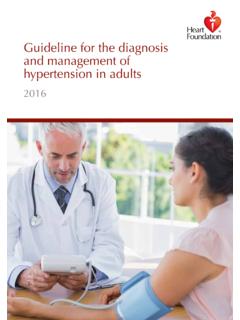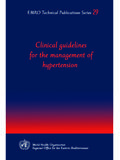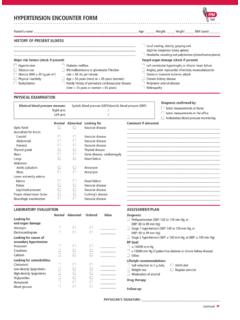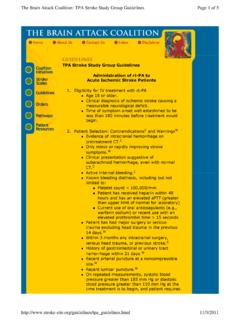Transcription of Central Blood Pressure Measurements and Antihypertensive ...
1 Central Blood Pressure Measurements and Antihypertensive therapy A Consensus Document Enrico Agabiti-Rosei, Giuseppe Mancia, Michael F. O'Rourke, Mary J. Roman, Michel E. Safar, Harold Smulyan, Ji-Guang Wang, Ian B. Wilkinson, Bryan Williams, Charalambos Vlachopoulos T he 2003 European Society of Hypertension/European Society of Cardiology guidelines for the management of arterial hypertension1 included 2 important novel recommen- Pathophysiological Significance of Central Pressures Central (aortic and carotid) pressures are pathophysiolog- dations: assessment of the total cardiovascular risk should be ically more relevant than peripheral pressures for the patho- taken into account in the management of the hypertensive genesis of cardiovascular ,4 It is aortic systolic patient, and quantification of risk should include subclinical Pressure that the left ventricle encounters during systole target organ damage. (afterload), and the aortic Pressure during diastole is a These guidelines acknowledged that Central (aortic) determinant of coronary perfusion.
2 Furthermore, the distend- Blood Pressure (BP), which is the Pressure exerted on the ing Pressure in the large elastic-type arteries (aorta and heart and brain, may be different from the Pressure that is carotid) is a key determinant of the degenerative changes that measured at the arm. They also recognized that Central characterize accelerated aging and hypertension. In contrast, Pressure may be predictive of outcome in specific popula- the muscular peripheral arteries, such as the brachial and the tions2 and differently affected by Antihypertensive drugs. radial ones, are less influenced by these However, although these guidelines accepted that Central The Pressure wave generated by the left ventricle travels augmentation index and pulse wave velocity may be down the arterial tree and then is reflected at multiple important as measures of subclinical organ damage, they peripheral sites, mainly at resistance arteries (small muscular also stressed the need for prospective trials to establish arteries and arterioles).
3 Consequently, the Pressure waveform recorded at any site of the arterial tree is the sum of the their predictive values given that such studies were lacking forward traveling waveform generated by left ventricular at that time (2003). ejection and the backward traveling wave, the echo of the After publication of these guidelines, additional data have incident wave reflected at peripheral sites. When the large strengthened the pathophysiological importance of Central conduit arteries are healthy and compliant, the reflected wave BP. Clinical studies have indicated that Central BP may have merges with the incident in the proximal aorta during dias- predictive value independent of the corresponding peripheral tole, thereby augmenting the diastolic BP and aiding coronary (brachial) BP. More importantly, recent large-scale trials perfusion. In contrast, when the arteries are stiff, pulse wave have shown that Central hemodynamics may provide a worth- velocity increases, accelerating the incident and reflected while treatment target.
4 In addition, Central hemodynamics can waves; thus, the reflected wave merges with the incident now be reliably assessed noninvasively with a number of wave in systole and augments aortic systolic rather than devices. Accordingly, because arterial stiffening and cen- diastolic Pressure . As a result, left ventricular afterload tral hemodynamics are markers and manifestations of increases, and normal ventricular relaxation and coronary organ damage, the pertinent key question is whether the filling are compromised. Apart from changes in the timing of balance of evidence on their importance and issues related the waveforms merging, changes in the magnitude of the to clinical practice allows for implementation in patient reflected wave and Central pressures may result from changes management. in the proportion of the incident wave that is reflected, which Received February 27, 2007; first decision March 22, 2007; revision accepted April 25, 2007.
5 From the Clinica Medica and Department of Medicine ( ), University Hospital, Brescia, Italy; Clinica Medica and Department of Medicine ( ), University of Milano-Bicocca, St Gerardo Hospital, Monza, Milan, Italy; St Vincent's Clinic/University of New South Wales ( ), Darlinghurst, Australia; Weill Medical College ( ), Cornell University, Ithaca, NY; Centre de Diagnostic ( ), Hopital Hotel-Dieu, Paris, France; Department of Medicine ( ), Upstate Medical University, Syracuse, NY; Centre for Epidemiological Studies and Clinical Trials ( ), Ruijin Hospital Shanghai Jiaotong, University School of Medicine, Shanghai, China; University of Cambridge Addenbrooke's Hospital ( ), Cambridge, United Kingdom; the Department of Cardiovascular Sciences ( ), School of Medicine, University of Leicester, Leicester, United Kingdom; and the First Department of Cardiology ( ), Athens Medical School, Hippokration Hospital, Athens, Greece. was writing coordinator for this article.
6 Correspondence to Charalambos Vlachopoulos, Kerassoundos 17, Athens 11528, Greece. E-mail (Hypertension. 2007;50:154-160.). 2007 American Heart Association, Inc. Hypertension is available at DOI: 154. Agabiti-Rosei et al Central Pressures and Hypertension 155. Figure 2. Central Pressure waveform. The height of the late sys- tolic peak above the inflection defines the augmented Pressure , and the ratio of augmented Pressure to PP defines the augmen- tation index (in percentage; modified from Reference 6). Figure 1. Change in contours in Pressure wave (top) and flow wave (bottom) between the ascending aorta and the saphenous artery (reprinted from Reference 3). pressures cannot be accurately calculated, these methods can display several features of the aortic (or carotid) pulse that are not dependent on the absolute values of BP, such as ampli- in turn depends on the balance between vasoconstriction and fication of the pulse wave between Central and peripheral vasodilatation in the peripheral circulation.
7 Artery, augmentation index, and arrival time of the reflected Another important consideration regarding the relationship wave (the latter 2 are, however, dependent on identification between brachial and Central aortic Pressure is Pressure of inflection point). Furthermore, because these features are wave amplification. Typically, the diastolic and mean pres- also influenced by factors including heart rate, height, and sures change little across the arterial tree. However, systolic age, modern computational capability could allow weighting BP is amplified when moving from the aorta to the periphery of these factors in appropriate formulas. Potential problems (Figure 1).3. related to the widespread application of arterial tonometry Consequently, the pulsatile components of Central and include appropriate training, supervision, and quality control, peripheral pressures (systolic BP and pulse Pressure [PP]) as they do for sphygmomanometry. may vary significantly.
8 In general, brachial systolic and PP Arterial wave reflections indices and Central pressures tend to overestimate Central systolic and PP, especially in coupled with measurement of aortic pulse wave velocity, a younger subjects who have more pronounced amplification. direct measure of arterial stiffness, constitute a comprehen- Substantial differences between Central and brachial BP are sive and integrated approach of the study of arterial also often also seen in older people, especially with This is further highlighted by a possible differential ability to tachycardia, exercise, use of vasoactive agents, or in those predict risk (augmentation index is better in younger persons with systolic heart failure. and pulse wave velocity is better in older persons14) or by situations where, contrary to the usual behavior, pulse Techniques to Assess Central Hemodynamics wave velocity and wave reflection indices move in oppo- Although Central pressures are ideally measured directly by site using invasive devices, several methods have been devised currently to derive Central pressures from analyses of ap- Central Pressures and Central Indices as planated carotid and radial pulses or carotid distension Markers and Predictors of Disease Among several commercial and noncommercial de- Central hemodynamic variables have been shown to be vices,3,6 11 the most widely used in clinical studies is the independently associated with organ damage, incident cardio- SphygmoCor device (AtCor Medical)
9 , which uses radial or vascular disease, and events both in the general population carotid pulses and a validated generalized transfer function to and in various disease ,16 40 Tables 1 and 2 show such estimate Central pressures from the peripheral signal (Figure associations according to population studied, variable mea- 2). When the applanated radial waveform is calibrated using sured, and site and mode (invasive or noninvasive) of direct intra-arterial pressures, the SphygmoCor calculations measurement . of aortic pressures are accurate,8,12 whereas the accuracy of this, as well as of other peripheral artery methods, decreases Central Pressures and Central Indices as when the radial pulses are calibrated using inaccurate cuff Markers of Disease and Predictors of This is also the case for carotid artery techniques. Surrogate End Points Alternatively, because mean BP remains virtually constant Increased aortic augmentation index is associated with coro- from Central to peripheral arteries, the mean BP value nary artery Central pressures also correlate with computed from the area of the applanated carotid artery cardiovascular risk not only in patients with atherosclerotic waveform can be calibrated using the mean BP obtained at disease but also in apparently healthy The late the brachial artery level.
10 Values of carotid pressures can then systolic augmentation of the Central Pressure waveform is be ,11 It should be emphasized that even when Central associated with an increase in left ventricular mass index 156 Hypertension July 2007. TABLE 1. Cross-Sectional and Longitudinal Studies Indicating the Independent Value of Central Hemodynamics as Markers of Disease and Predictors of Surrogate Cardiovascular End Points Source Year, Country Population Design Parameter End Point Saba et al * . 16 1993, United States Normotensives Cross-sectional Carotid AIx LVMI, carotid thickness Boutouyrie et al17* 1999, France Hypertensives Cross-sectional Carotid PP Carotid thickness Boutouyrie et al18* 2000, France Hypertensives Longitudinal (9-month FU) Carotid PP Carotid IMT reduction with treatment Roman et al19 2000, United States Normotensives, Hypertensives Cross-sectional Carotid systolic BP Relative LV wall thickness Waddell et al20* 2001, Australia CAD Cross-sectional Carotid BP Extent of CAD.












